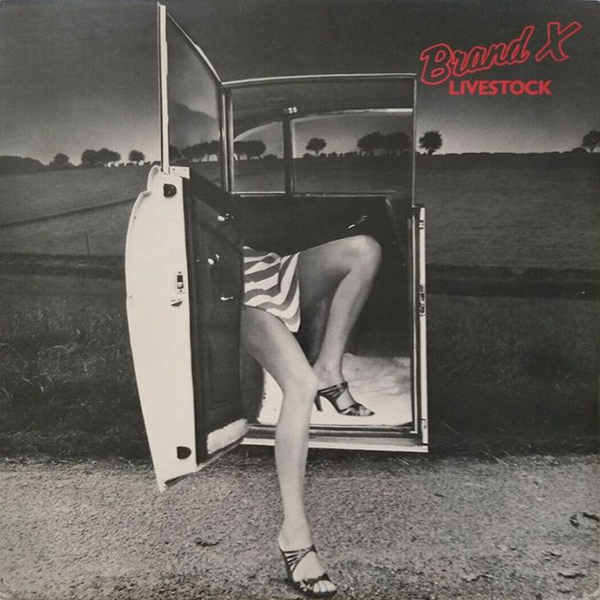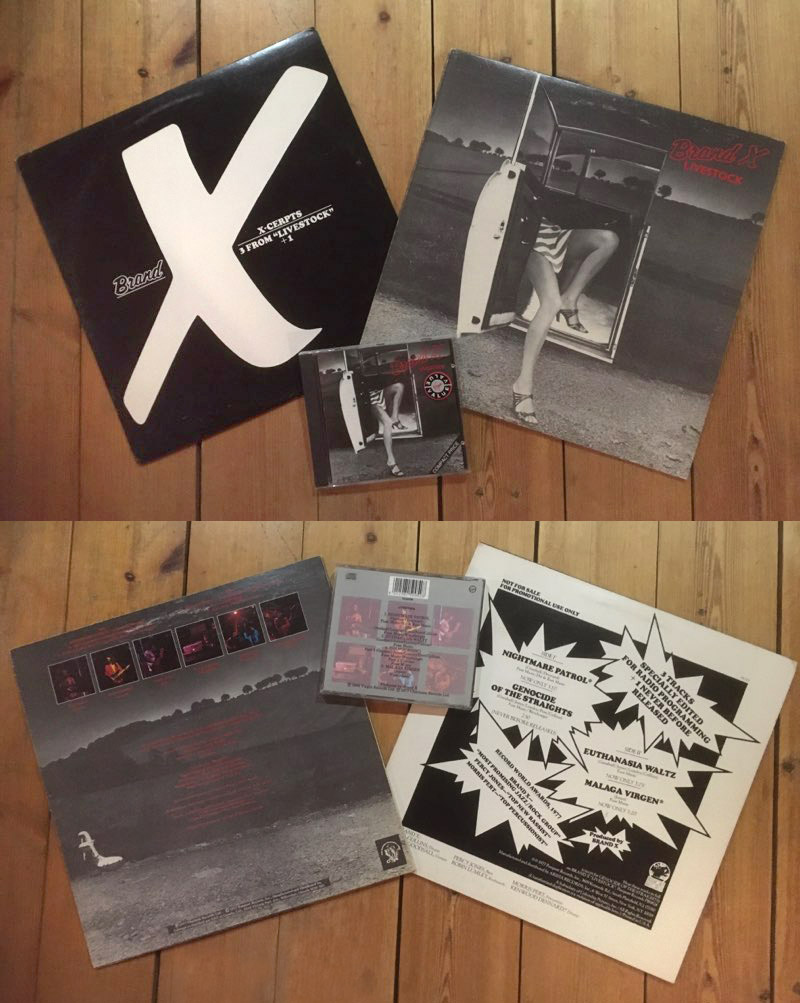- Article
- Read in 5 minutes
Brand X – Livestock – album review
The first live album of Phil Collins’ second band at the time was Livestock, released just a few weeks after Seconds Out. Thomas Jesse reviews this album.
By 1977 Brand X had found a replacement for Phil Collins, who was increasingly occupied with Genesis. His name was Kenwood Dennard. With him, the band went on a tour through the U.S. in June and July 1977 to entertain their American fans *1).
At the time, Brand X were a rising star in the jazz-rock-fusion sky. They had two successful studio albums and kept touring ever more frequently in clubs and smaller venues to feed the success. More time on tour means less time for studio work, though. In order to close the gap and to fulfil the demand, Charisma decided to release a live album. It came out in time for the Christmas business on November 18, 1977, roughly a month after Genesis’s Seconds Out.
The album – title and design:
The album title, livestock, refers (roughly) to the inventory of animals on a farm. It puns on a band that performs the stock of their material, as it were, in a live situation and also on the band as the living inventory of a club linking up to an equally live audience.
The cover was designed by Hipgnosis once more. The door frame of a limousine and the legs of a woman apparently about to step out of the car are set against a dark, lonely landscape. The back cover shows only the backdrop, a bit of chrome from the car and coloured photos of the musicians that stand out from the black and white cover.
“Set against the rolling hills of Berkshire, the picture is as much about the endless travel that musicians experience on the road and the loss of a normal life outside that peculiar bubble. The expensive and half-invisible limosousine is a life half missing, the girl is the temptation inside the bubble; the landscape behind is the normality that dissapears over the horizon. This is a Hipgnosis visual interpretation oft he narrative. We couldn’t tell it in a song but we could in a picture.”*2
Unfortunately, this was not a double album. It was accompanied by a promo maxi called X-Cerpts with abbreviated versions of Euthanasia Waltz, Malaga Virgin and Nightmare Patrolas well as a studio outtake from the Moroccan Roll-sessions, Genocide Of The Straights. (The shorter versions are advertised in most euphoric terms on the back!).
 Unfortunately, the five songs on the album are not all from one show. *3
Unfortunately, the five songs on the album are not all from one show. *3
The recordings are from three different shows and locations, which gives the album the impression of a compilation. The slightly negative aftertaste disappear at the sight of the tracklist. Three of the tracks are new and/or have never been released as studio tracks. Plus, the recordings are not completely devoid of Phil Collins: He drums on three of the tracks and supports Kenwood Dennard on percussion on the other two track.
Nightmare Patrol
Recorded at the Hammersmith Odeon, London, on August 05, 1977. Phil Collins joins as a guest and supports drummer Dennard on percussion. It’s a new song composed by Goodsall and Dennard. Quiet, gull-like sounds blend us into the concert. The guitar welcomes us before bass and drums draw it into a cascade of jazzrock that sounds very improvised. The piano starts tinkling, the track winds its way through numerous time signatures until it reaches the grand finale with delightful guitar solos worthy of an Al Di Meola. What a bass sound, what competing percussion drum rolls! A tour de force through the cosmos of Brand X that ends … very quietly … after eight minutes.
Ish
This previously unreleased track was recorded in August or September 1976 at Ronnie Scott’s in London. This is the Moroccan Roll line-up striking it up. Jones’s bass welcomes us along with percussive parts by Collins and Pert. The calm is blown away by Collins’s turbulent drumming, guitars murmur, the bass bubbles away and the synthesizers squeak. The music grips the listener and pulls them into a world of sound in which they can relax and tap along with the beat. The track rewards the focused listener because there are so many sound gems to be found. Each instrument gets its own solo. Goodsall’s guitar stands out as he plays it serving the rhythms or serving the melody.
Euthanasia Waltz
This track from Unorthodox Behaviour was recorded at the Marquee Club in London on April 23, 1977. As this date coincided with a break in the Genesis tour schedule Phil took the opportunity to play with them. The performance is much straighter, rockier than the studio version. The guitar sounds harder. Oh, how Collins drums, and listen to Lumley! A high point of the album, but is it a waltz? Rather an acoustic roller-coaster ride that vanishes in a quick fade-out that was quite uncalled-for!
Isis Mourning (Part 1 & 2)
… comes, like Ish, from the 1976 shows at Ronnie Scott’s. It is another new track. The piece begins with relaxed drums and percussions, gently accompanied by the keyboards. The guitar joins them in the same laid-back fashion while the bass holds everything together. The listener drifts down the river of music in a very relaxed, floating, ambient way. The occasional solos don’t startle them; they are like eddies that the boat floats around. The percussion is like ripples reaching the water’s edge. The atmosphere grows darker, a bit more threatening, though the current becomes just a bit faster. It is obvious that the band could continue this relaxed jam for hours, but the decide to have a foaming, abrupt ending.
Malaga Virgin
Don’t fall asleep yet! This is the album finale, recorded on August 05, 1977 at the Hammersmith Odeon: Harsh, full of bass, with thundering drums. A rock track with little jazz. Dennard plays great drums, quite worthy of Collins’s drumming. The break in the middle of the track surprises me every time. All of a sudden it calms down and grows jazzier. Percy Jones has a great time while the guitar and the keyboards battle for supremacy. Neither wins, of course. The real winner is the audience who get to listen to hear this frantic finale, who got to see this band play live.
All in all
This fine sampler has little live atmosphere but illustrates the musical concept of the band very well. Listeners have to deal with beautiful jazz rock that, though it is partly improvised, always follows a structure. Brand X move along the tracks of Weather Report, the Mahavishnu Orchestra and similar act of the fusion music genre. You can see the band slowly emancipating themselves from a Phil Collins and his growing fame. At this point they have not dared to do the final step and have a live recording without him. Phil, on the other hand, would play and play, most of the time with Genesis on their long tours, occasionally at home with Brand X or as a session musician for others. A live album divided into two halves – one with Phil, one without Phil, e.g. from their North American tour in spring/summer 1977 – might have been more intriguing. As it is, the album is somewhat ambiguous: a treat for the Brand X aficionados, or an introduction for newcomers to the band? Not enough for the former, too complicated for the latter?
The reviewer enjoyed it and recommends Livestock along with Product (which came out two years after) as an introduction to Brand X, the band that is so much more than just “Phil Collins’s side project.”
*1) For more information be sure to check out the excellent research Steffen Gerlach has turned into the history of Brand X at: https://www.genesis-news.com/c-Brand-X-An-Unorthodox-History-c274.html This reviewer owes you, Steffen!
*2: from: Aubrey Powell, Vinyl. Album. Cover. Art, The Complete Hipgnosis Catalogue, London 2017,
S. 217
*3) Recordings of complete shows would surface many years later as official bootlegs. They have been collected in the Livevox box.
In Memoriam Morris Pert, 08.09.1947 – 27.04.2010

